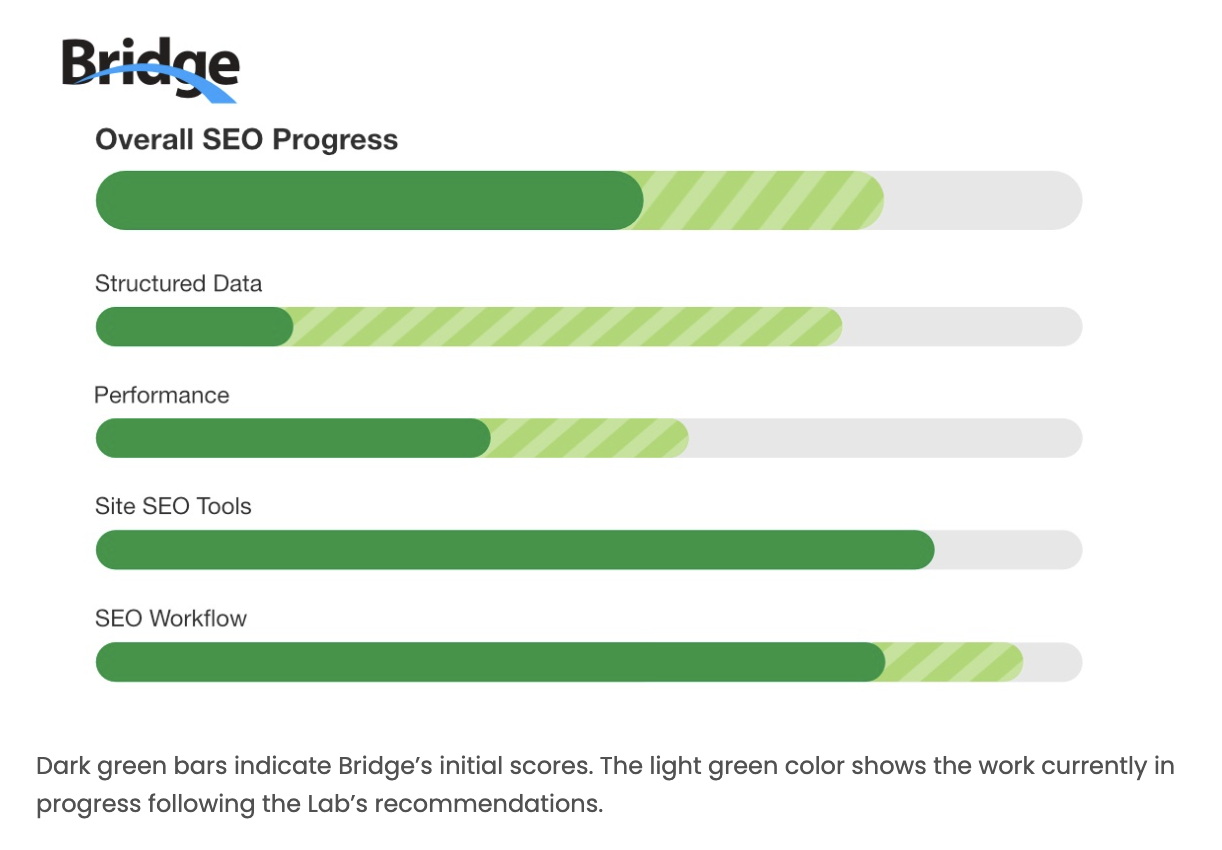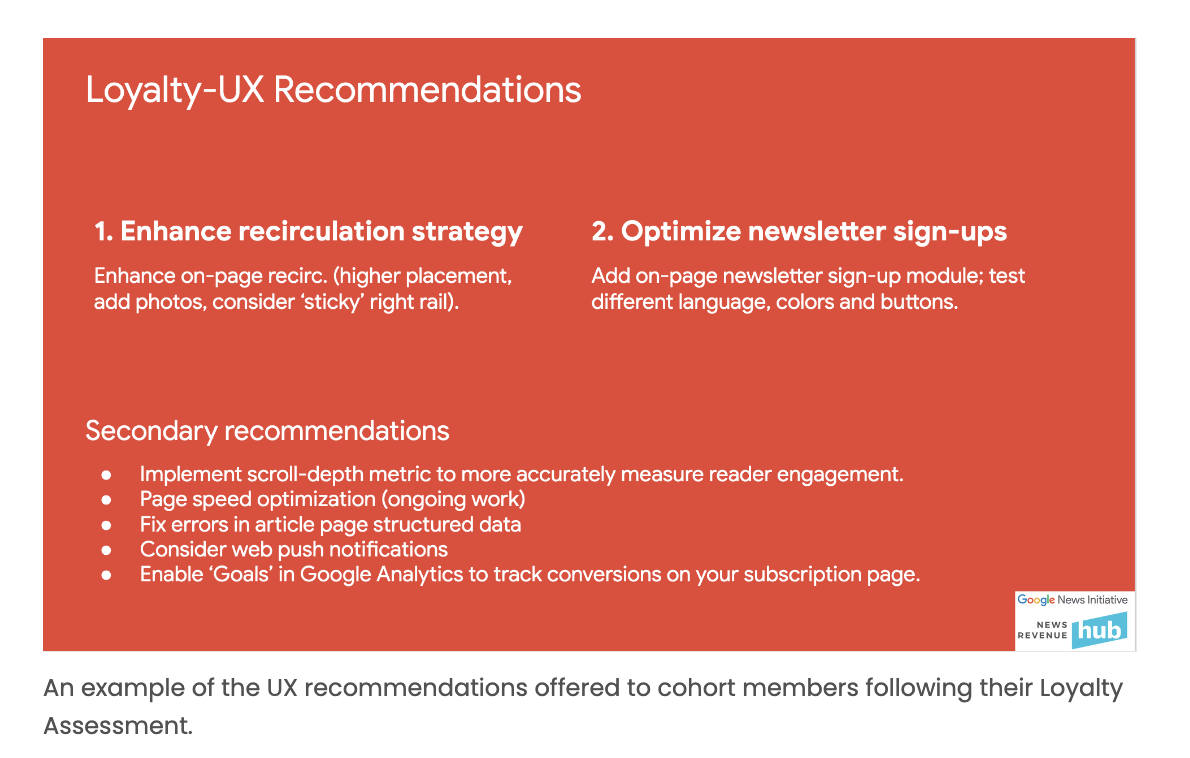Here’s How the GNI Audience Lab Does Assessments
Last month, we announced the Google News Initiative Audience Lab, a pilot project at the News Revenue Hub dedicated to helping clients grow and enhance their audiences. In that intro post, we laid out the type of work the Lab is doing as it seeks to help publishers grow and enhance their audiences. Now we want to take a deeper dive into that work.
The GNI Audience Lab is currently conducting assessments for seven Hub clients around five key areas that impact audience growth: loyalty, user experience, SEO, newsletters, and organization structure. The cohort, which is made up of clients of varying sizes, includes local outlets Bethesda Beat and Rivard Report; regional publications Bridge Magazine and CalMatters; and national organizations the Center for Public Integrity, the Center for Investigative Reporting, and Next Avenue.
We identified these categories based on survey results from the clients we’re working with, along with our own audience growth research and in-house expertise. For most of these areas, the Lab is creating scorecards that measure how each newsroom is performing. Every assessment also comes with customized recommendations for how to improve their approach.
“The assessments have shown some very promising results,” said Evan Mackinder, the News Revenue Hub’s director of audience development. “We’ve been able to give each organization a number of action items, and they’re attacking them as best they can.”
A hands-on approach for a major source of traffic
So far, we’ve assessed each organization’s capabilities and strategy around SEO, or search engine optimization. SEO is increasingly seen as a vital stream of traffic for news organizations, but too many of them are still receiving those visits passively. We’re taking a holistic approach to SEO strategy, analyzing clients in four major categories: structured data, site performance, SEO tools, and editorial workflow.
“SEO has grown to become a hugely important stream of traffic, in many cases replacing the losses that news organizations have experienced from social media in recent years,” explained Mackinder. “These recommendations are really about moving clients from passively accepting that traffic to creating a strategy for actively courting it.”
All seven organizations received SEO scorecards, along with recommendations on what they could do to better harness search traffic. Those recommendations ranged from quick fixes, such as choosing the right size and format for photos, to longer-term solutions, like implementing an editorial SEO strategy.
“Working with Evan and Arjuna [Soriano, the Lab’s product manager] gave me a team of talented people to bounce ideas off of, often in real time,” Emkow said. “I know most of the fundamentals of SEO, but with the Audience Lab in place I now have a place to turn to discuss in detail what I was trying to accomplish. They are a highly-responsive team to brainstorm ideas as to why it may not be working. They’re also capable of following up with me to make sure I stay on task. It’s been very helpful.”
The Lab’s recommendations included paying closer attention to major trending topics, adding structured data, and identifying ways to reduce load times. The Bridge staff has begun implementing those recommendations, and is already seeing results.

The Lab team has also created SEO resources to help the members in the cohort execute recommendations that often extend beyond their purview. The Lab held an SEO headline training that editors were invited to join, for example, and handed out “cheat sheets” that could be distributed throughout the newsroom. “We understand that moving the needle on something like SEO will take more than just one person in each newsroom,” Mackinder said.
“From here, cohort members will continue to implement the Lab’s SEO recommendations, and we’ll test to see what’s working” said Mackinder.
From casual readers to brand lovers
The Lab’s next assessments center around loyalty and user experience, or UX. “Loyalty is our North Star metric at the Hub,” said Mackinder. “Loyal readers not only return to your site, they also spread the word to friends, and are most likely to donate and become members. So we really want these newsrooms to focus on finding more of the repeat visitors that will invest in their future.”
Loyalty is also a hard thing to assess. That’s where the Google News Initiative’s News Consumer Insights tool comes in handy. “From our work with hundreds of news publishers around the world, we’ve learned that focusing on user engagement and loyalty is critical for any news organization to continue growing,” said Anntao Diaz, head of News Consumer Insights & Realtime Content Insights at Google.
“We created NCI to simplify analytics data and transform insights into actionable recommendations for news publishers,” added Diaz. “We also wanted to support local news organizations that may have limited in-house resources to make data-driven decisions.”
News Consumer Insights, or NCI, measures loyalty by identifying gaps in user engagement across a news site’s audience through Google Analytics and industry benchmarks. Diaz explained that the free tool, which was built in collaboration with news publishers, visualizes different reader segments and how they engage with a news site.
“The end goal is to provide insights that help our news partners move audiences from the ‘Casual Readers’ segment down the funnel to becoming ‘Loyal Readers,’ ‘Brand Lovers,’ or even ‘Subscribers,’” Diaz said.

The NCI team also created a custom metric, called “User Value Score” (UVS), to help news organizations understand the value of each audience segment to their specific publication. This composite score is calculated using key engagement metrics (pageviews per user, average session duration, average sessions per user, and average pages per session) and measured across industry benchmarks, providing a quick overview of how a site’s audience is performing compared to news peers.
“Combined with actionable recommendations from the News Consumers Insights Playbook, UVS can help publishers identify gaps in business strategy and inform how to adapt resources accordingly to grow overall loyalty,” Diaz said.
There are more learnings ahead for the GNI Audience Lab cohort: Members will soon receive assessments on their newsletter products. The final assessment will be organizational structure. News Revenue Hub Founder and CEO Mary Walter-Brown will team up with Mackinder to talk with the cohort about how the newsroom of the future is inserting audience strategy directly into the organization’s DNA and executive team—and about how these publishers might make similar structural moves.
“This is a lot of work, and we’re eager to see how it will pay off,” said Mackinder. “Building loyal audiences doesn’t happen overnight, but it is very possible. We’re learning a lot through this process—as are the newsrooms we’re working with—and we’re excited to share those learnings.”
The Audience Lab is committed to scaling these lessons to more publishers through an open playbook. Stay tuned!